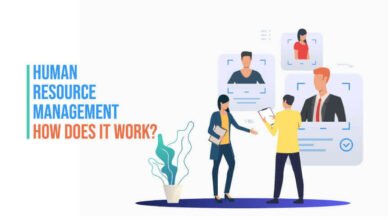Human Resource Management Model
The human resource management model is a system that organizations use to manage employee relations. The model has three main goals: planning and forecasting, organizing and directing, and controlling and appraising. Each goal has several steps that need to be followed in order to be successful. All goals are run on the characteristics of human resource management.
However, before going to the main topic, we should understand what is human resource management and the human resource management model.
What is Human Resource Management?
Human resource management is the practice of managing people within a company (HRM). It includes activities such as recruiting, selecting, training, appraising, and compensating employees which are the principles of HRM. HRM also helps to ensure that the individual goals of employees are aligned with the goals of the organization. If you want to know more about it and how to work it, you can read what is Human Resource Management article.
What is Human Resource Management Model?
The HRM Model is a business model that helps companies manage their employees. It includes processes for hiring, training, and managing workers, its other name is the phases of Human Resource Management. The goal of the HRM Model is to help businesses find and keep the best employees possible.
Human Resource Management Model
In recent years, there has been a fair amount of consensus among experts in the field of human resource management as to what makes up this discipline. The model that serves as the focal point for the training and development of human resources was created by the American Society for Training and Development (ASTD). The ASTD research highlighted nine areas for human resource development. In the context of the existing application of HRM, we can propose a separate model for Human Resource Management consisting of fifteen areas. The following list of model elements can be briefly discussed:
1. Human Resource Planning
The primary goals of human resource planning are to ensure that the organization has the right number and types of employees, with the necessary skills and abilities, to achieve its strategic objectives. Other key goals include developing a workforce that is aligned with the organization’s values and culture, and ensuring that employees are treated fairly and equitably. All things are related to the objectives of HRM.
2. Recruitment and Selection
Human resource management hires and chooses only skilled and productive personnel through recruiting and selection. These are the process or model’s entry-level functions for human resource management. After job design or recruiting, the most suitable individuals are picked from the pool of applicants. Needs for staffing and selection align people’s requirements and abilities for their careers with jobs and career routes.
3. Promotion and Transfer
Human resource management is responsible for the promotion and transfer of employees within an organization. They must follow the established rules or procedures in order to ensure a smooth transition for both the employee and the company. By doing so, HRM can help to improve productivity and minimize disruption.
4. Job Design and Analysis
Organizational job design focuses on defining how task authority and systems will be organized and integrated across organization units and in individual jobs.
5. Job Evaluation
According to the evaluation and development of HRM, it is essential for any company. It helps to train and develop staff while taking into account the needs of the person, the company, and the training facility. This allows for a well-rounded workforce that can benefit everyone involved.

6. Training and Development
Human resources management (HRM) training and development is a process that helps businesses assess the jobs of their employees in order to create a well-conceived pay plan. By evaluating each employee’s job duties, employers can identify what skills and knowledge are required for the position and then develop corresponding training programs. This process also allows employers to identify any gaps between an employee’s current skillset and what is needed for the job, so they can work on closing that gap. Ultimately, this systematic assessment results in better-trained employees who are better suited for their roles within the company.
7. Rewards and Benefits
All employee benefits, both extrinsic and intrinsic, are referred to as compensation. It includes benefits also. Its main goal is to provide advantages, fairness, and consistency in remuneration.
8. Merit Rating
It is a systematic evaluation of the nature of the performance of finally selected and posted employees at the right place. The primary objective is to provide them with benefits packages.
9. Career Development
Career development is the personal improvement employee understands to achieve a personal career plan. The group provides it as a way to raise members’ awareness. Career development policies draw in devoted workers and maintain their loyalty to the company.
10. Grievance Handling
Grievance handling is another crucial human resource management duty that may be used to resolve or eliminate employee unhappiness. Otherwise, the employee cannot deploy his effort to the organization.
11. Disciplinary Action
Discipline issues can seriously hurt an organization’s performance. Therefore, Human Resource Management is to take or adopt their hot stove approach or progressive approach for disciplinary purposes.
12. Employee Service/Welfare
Employees should receive some extra benefits on top of their normal compensation from human resource management in order to motivate and energize the workforce.
13. Communication
To guarantee employee involvement and participation, every decision, work plan, strategy, or technique of work should be clearly explained to the employees before execution.
14. Human Resource Costing and Audit
Human resource management should conduct an audit of the current situation and anticipated future needs of employees for the company, as well as assess costs and benefits for and from the employees.
15. Labor Relations
It focuses on ensuring healthy organizational relationships. A pleasant working environment and industrial harmony depend on human relationships.
In fine, in industrial organizations with the existing application of HRM, the Human Resources Management model can be applied judiciously. There is a chance of significant success if the organization follows every aspect of the concept.
How to Implement HRM Model in Organization?
In the importance of HRM, there is no one-size-fits-all answer to this question, as the best way to implement an HRM model will vary from organization to organization. However, some tips on how to do so include ensuring that the HRM model is aligned with the company’s overall strategy and goals, making sure that all employees are aware of and understand the new system, and providing adequate training for those who will be using it.
Benefits of the HRM Model
The HRM model has different benefits for everyone. It can help organizations manage their employees more effectively, which can lead to increased productivity and efficiency. The HRM model can also help employees better understand their roles within the organization and improve communication between managers and employees.
Drawbacks of the HRM Model
If we go back to the history of human resource management, the HRM model has both benefits and drawbacks. One drawback is that it can be expensive to implement and maintain. Additionally, the HRM model can be time-consuming, requiring significant resources to develop and administer policies and procedures. Another potential downside is that the HRM model may not always reflect the unique needs of a company or organization.
Final Verdict
The final verdict of the HRM Model is that it is a very useful tool for organizations. It helps to identify and assess the key areas that need improvement in order to create a more effective and efficient workforce. Additionally, the Human Resource Management Model can also be used to identify potential problems and develop strategies to prevent them from happening.



